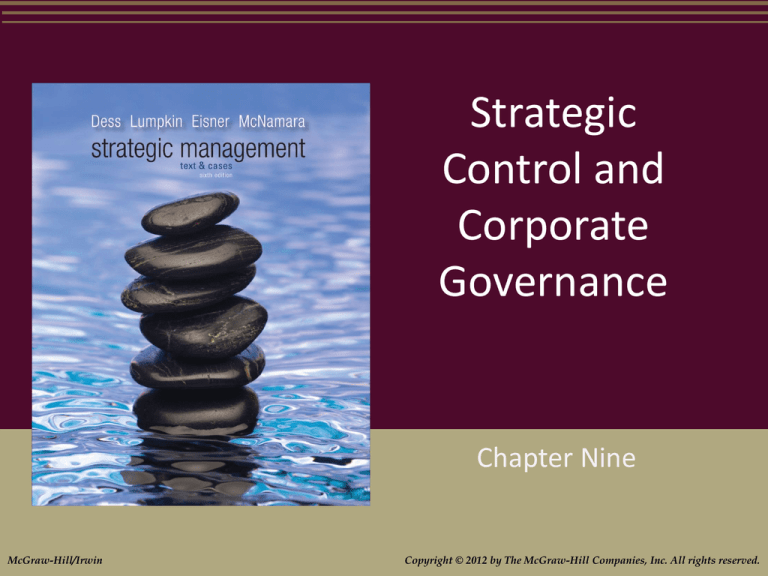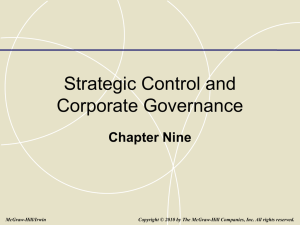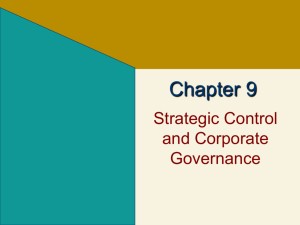
Strategic
Control and
Corporate
Governance
Chapter Nine
McGraw-Hill/Irwin
Copyright © 2012 by The McGraw-Hill Companies, Inc. All rights reserved.
Learning Objectives
After reading this chapter, you should have a
good understanding of:
LO9.1 The value of effective strategic control
systems in strategy implementation.
LO9.2 The key difference between “traditional” and
“contemporary” control systems.
LO9.3 The imperative for “contemporary” control
systems in today’s complex and rapidly
changing competitive and general
environments.
9-2
Learning Objectives (cont.)
LO9.4 The benefits of having the proper balance
among the three levers of behavioral control:
culture, rewards and incentives, and boundaries.
LO9.5 The three key participants in corporate
governance: shareholders, management (led by
the CEO), and the board of directors.
LO9.6 The role of corporate governance mechanisms
in ensuring that the interests of managers are
aligned with those of shareholders from both the
United States and international perspectives.
9-3
Strategic Control
Strategic control
the process of monitoring and correcting a
firm’s strategy and performance
Informational, behavioral
9-4
Ensuring Informational Control
Traditional control system
1. strategies are formulated and top
management sets goals
2. strategies are implemented
3. performance is measured against the
predetermined goal set
9-5
Traditional Approach to
Strategic Control
Exhibit 9.1
9-6
Traditional Approach
to Strategic Control
Most appropriate when
Environment is stable and relatively simple
Goals and objectives can be measured with
certainty
Little need for complex measures of
performance
9-7
Contemporary Approach
to Strategic Control
Exhibit 9.2
9-8
Contemporary Approach to Strategic
Control
Informational control
a method of organizational control in which a
firm gathers and analyzes information from the
internal and external environment in order to
obtain the best fit between the organization’s
goals and strategies and the strategic
environment.
9-9
Question
Top managers at USA Today meet every Friday to
review daily operational reports and year-todate data. This is an example of
A. Behavioral control
B. Informational control
C. Strategy formulation
D. Strategy implementation
9-10
Informational Control
Primarily concerned with whether or not the
organization is “doing the right things”
Key question
“Do the organization’s goals and strategies
still ‘fit’ within the context of the current
strategic environment?”
9-11
Informational Control
Two key issues
Scan and monitor external environment
(general and industry)
Continuously monitor the internal
environment
9-12
Contemporary Approach
to Strategic Control
Behavioral control
a method of organizational control in which a
firm influences the actions of employees through
culture, rewards, and boundaries.
9-13
Effectiveness of Contemporary Control
Systems
1.
2.
3.
4.
Focus on constantly changing information that
has potential strategic importance.
The information is important enough to demand
frequent and regular attention from all levels of
the organization.
The data and information generated are best
interpreted and discussed in face-to-face
meetings.
The control system is a key catalyst for an
ongoing debate about underlying data,
assumptions, and action plans.
9-14
Behavioral Control
Behavioral control is focused on
implementation—doing things right
Three key control “levers”
Culture
Rewards
Boundaries
9-15
Reasons for an increased emphasis on
culture and rewards
1.
The competitive
environment is
increasingly
complex and
unpredictable,
demanding both
flexibility and quick
response to its
challenges.
2. The implicit longterm contract
between the
organization and its
key employees has
been eroded.
9-16
Building a Strong and Effective
Culture
Organizational culture
a system of shared values and beliefs that
shape a company’s people, organizational
structures, and control systems to produce
behavioral norms.
9-17
Building a Strong and Effective
Culture
Culture sets implicit boundaries (unwritten
standards of acceptable behavior)
Dress
Ethical matters
The way an organization conducts its
business
9-18
Example: Wal-Mart
A lot of Wal-Mart's success was attributed to the
strong and pervasive culture at the company,
which was developed and nurtured by founder
Sam Walton.
In over four decades of operation, Wal-Mart
managed to retain most of the elements of
culture it had when it first started out, as well as
the entrepreneurial spirit which often drives
startup companies to success.
9-19
Sustaining an Effective Culture
Effective culture
must be
Cultivated
Encouraged
Fertilized
Maintaining an
effective culture
Storytelling
Rallies or pep
talks by top
executives
9-20
Motivating with Rewards and
Incentives
Rewards and incentive systems
Powerful means of influencing an
organization’s culture
Focuses efforts on high-priority tasks
Motivates individual and collective task
performance
Can be an effective motivator and control
mechanism
9-21
Motivating with Rewards and
Incentives
Potential downside
Subcultures may arise in different business
units with multiple reward systems
May reflect differences among functional
areas, products, services and divisions
9-22
Characteristics of Effective Reward and
Evaluation Systems
Exhibit 9.4
9-23
Setting Boundaries and Constraints
Focus efforts on strategic priorities
Provide short-term objectives and action
plans
Specific and measurable
Specific time horizon for attainment
Achievable, but challenging
9-24
Setting Boundaries and Constraints
Improve operational efficiency and
effectiveness
Minimize improper and unethical conduct
9-25
Question
Effective boundaries and constraints:
A. Tend to inhibit efficiency and effectiveness
B. Distract employees who are trying to focus on
organizational priorities
C. Minimize improper and unethical conduct
D. Tend to limit organizational growth
9-26
Organizational Control:
Alternative Approaches
Exhibit 9.6
9-27
Evolving from Boundaries
to Rewards and Culture
System of rewards and incentives
coupled with a strong culture
Hire the right people
Training plays a key role
Managerial role models are vital
Reward systems clearly aligned with
organizational goals and objectives
9-28
Role of Corporate Governance
Corporate governance
the relationship among various participants
in determining the direction and performance
of corporations.
primary participants are the shareholders,
the management, and the board of
directors.”
9-29
The Modern Corporation
Corporation
A mechanism
created to allow
different parties to
contribute capital,
expertise, and labor
for the maximum
benefit of each
party.
9-30
Agency Theory
Deals with the relationship between
Principals – who are owners of the firm
(stockholders)
Agents – who are the people paid by
principals to perform a job on their behalf
(management)
9-31
Agency Theory: Two Problems
1.
The conflicting
goals of principals
and agents, along
with the difficulty of
principals to
monitor the
agents, and
2. The different
attitudes and
preferences
towards risk of
principals and
agents.
9-32
Governance Mechanisms
Board of directors
a group that has a fiduciary duty to ensure
that the company is run consistently with the
long-term interests of the owners, or
shareholders, of a corporation and that acts
as an intermediary between the
shareholders and management.
9-33
The New Rules for Directors
Exhibit 9.7
9-34
Governance Mechanisms
Shareholder activism
actions by large shareholders, both
institutions and individuals, to protect their
interests when they feel that managerial
actions diverge from shareholder value
maximization.
9-35
TIAA-CREF’s Principles on the Role of Stock
in Executive Compensation
Exhibit
9.8
9-36
External Governance
Control Mechanisms
External governance control
mechanisms
methods that ensure that managerial actions
lead to shareholder value maximization and
do not harm other stakeholder groups and
that are outside the control of the corporate
governance system.
9-37
External Governance
Control Mechanisms
Market for corporate control
Auditors
Banks and analysts
Regulatory bodies
Media and public activists
9-38
Sarbanes-Oxley Act
Auditors
Barred from certain types of non-audit work
Not allowed to destroy records for five years
Lead partners auditing a firm should be
changed at least every five years
9-39
Sarbanes-Oxley Act
CEOs and CFOs
Must fully reveal off-balance sheet finances
Vouch for the accuracy of information
revealed
Executives
Must promptly reveal the sale of shares in
firms they manage
Are not allowed to sell shares when other
employees cannot
9-40








